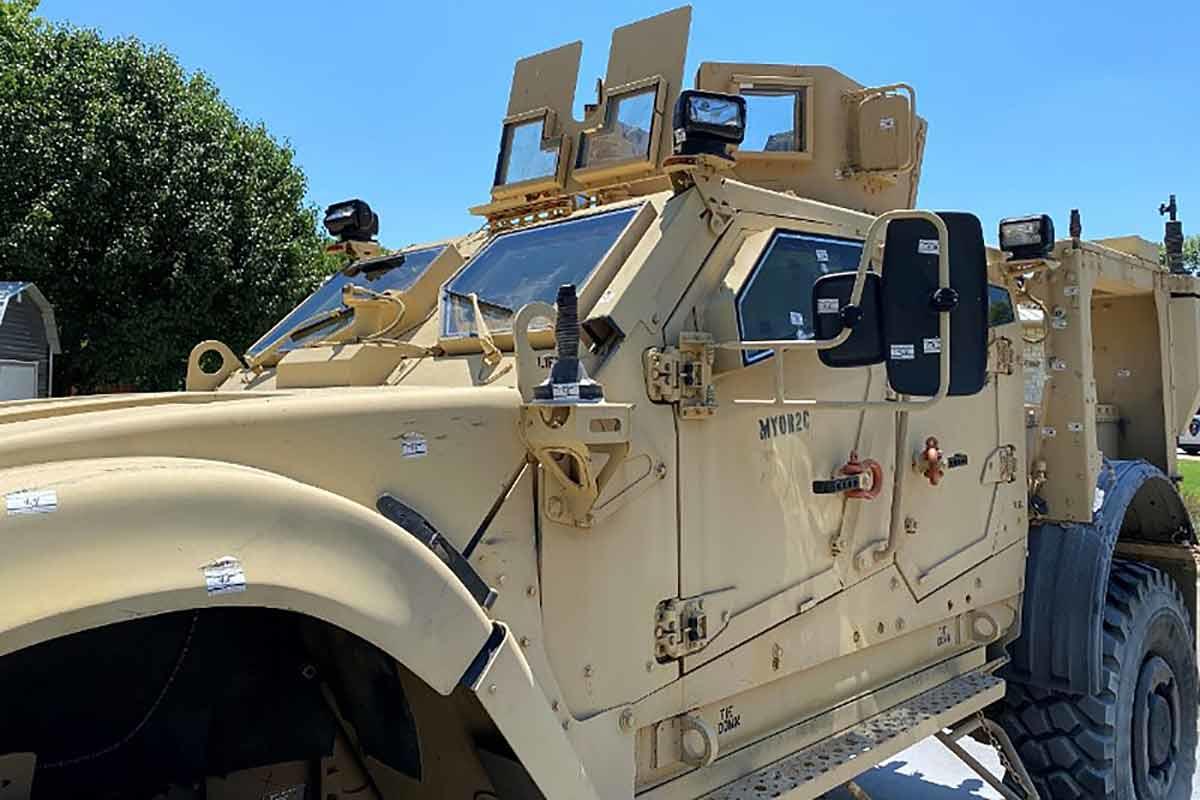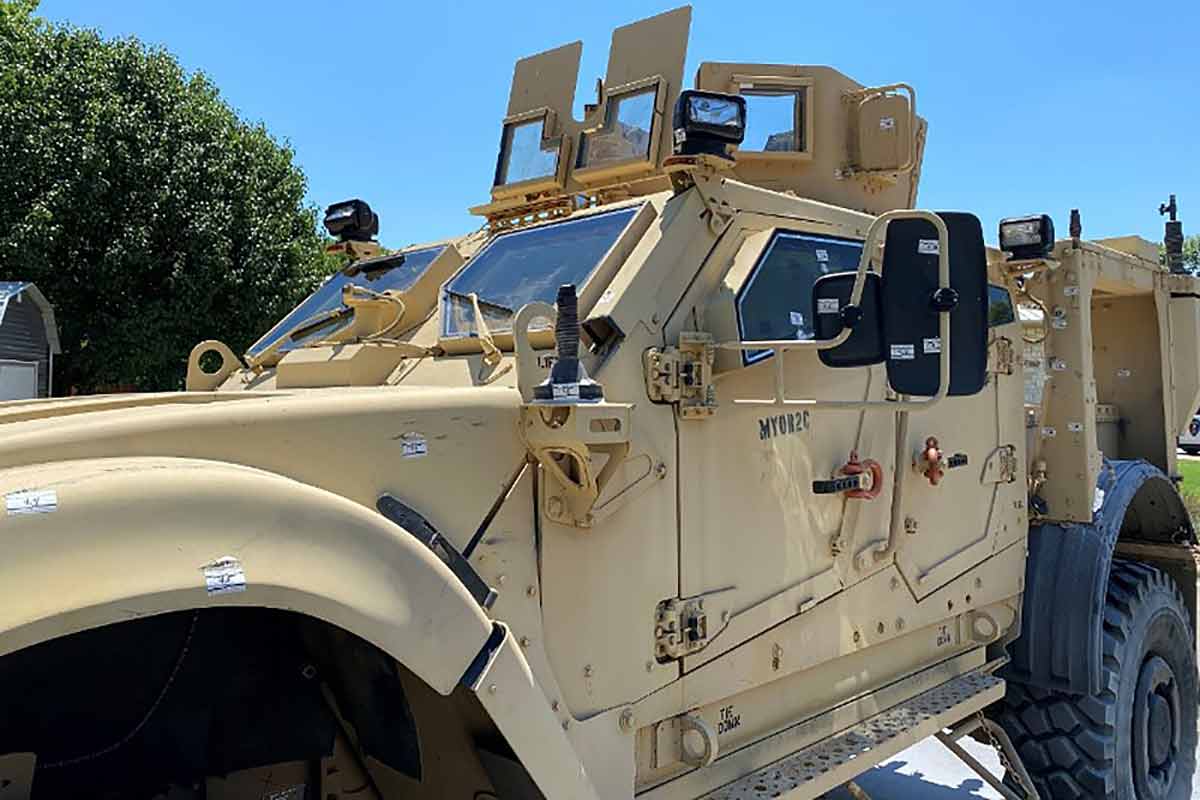

The Pentagon’s office for logistics is hailing a win for a controversial program that gives cast-off military combat gear and vehicles to civilian law enforcement agencies after a police department in Texas deployed an Mine-Resistant, Ambush-Protected vehicle in response to an active shooter.
According to a release from the Defense Logistics Agency, the Paris, Texas, Police Department responded to a June 16 call for assistance with a barricaded suspect by sending out a SWAT team and the 26-ton MRAP — a combat vehicle designed to withstand blasts from roadside bombs in Iraq and Afghanistan. An unidentified gunman carrying “high-powered rifles, shotguns and handguns” had fired on and hit a responding police officer and a patrol car before barricading himself inside a residence, the release states.
“The MRAP allowed the response team to safely approach the residence and provided some additional barrier from bullets for surrounding residences and businesses,” it adds. “[Criminal Investigative Division Police Lt. Doug Murphy said the vehicle took at least 30 rounds with the team inside, but it performed well, needing only replacement mirrors, spotlights, one window and a gallon or two of touch-up paint.”
Read Next: AC-130 Gunship Crew Gets Distinguished Flying Cross, Air Medals for Saving 88 Lives in Battle
In a statement to the DLA, Murphy hailed the vehicle’s contribution to the operation.
“This would not have been possible without the use of the MRAP, and its protection is, in my opinion, priceless,” he said. “It kept my guys safe, simple as that.”
The DLA frequently publishes news releases about ways law enforcement agencies have been able to use donated military combat vehicles that would have otherwise been destroyed as excess equipment. In January, it highlighted the use of former military vehicles in a shootout in Springfield, Ohio; in May 2020, it ran a story about an MRAP used to rescue locals from flooded homes in Saginaw and Bay City, Michigan.
For the military, excess equipment can be a massive headache. In 2013 and 2014, the Pentagon urged allies and civil agencies to take thousands of MRAPs and other combat vehicles off its hands as operations changed and it looked to more versatile options. The alternative is shredding or scrapping, which can be costly.
But the Defense Department’s touting of the Law Enforcement Support Office, or LESO, program, which has transferred more than $7.5 billion worth of military gear to over 8,000 partnering law enforcement agencies since it began in 1997, comes as many decry the program.
In the wake of the 2020 protests over the death of George Floyd at the hands of a police officer in Minneapolis, McClatchy published an investigation into the transfer of military gear to law enforcement. It found that of the 15 police departments with the highest number of police-involved killings, seven had received a larger share of military weapons through the LESO program. As of July 2020, McClatchy reported, 1,059 hulking MRAPs, valued at $700,000 apiece, had been gifted to police departments.
Last year, on the heels of outcry over police militarization, a provision that would have prohibited the transfer of MRAPs, weapons and other military paraphernalia to law enforcement agencies was introduced in the Senate, but failed to pass. A more narrow version that restricted transfers of grenades and certain other weapons and weaponized vehicles did make it into the fiscal 2021 National Defense Authorization Act.
Military transfers continue, and so does concern from some citizens. In a June 24 letter to the editor published in the Gazette out of Cedar Rapids, Iowa, citizen Tara McGovern speaks out on the pending transfer of an MRAP to the Johnson County Sheriff’s Office.
“You will see the sheriff dismiss concerns about the weight of the MRAP (26 tons) by stating that it’s ‘lighter than a firetruck.’ The reality is that damage to roads and property is a major reason why many communities have already phased out similar armored transport in their cities,” she writes of a recent county board meeting. “You will see the sheriff refuse to rule out the use of armored transport in future protest scenarios even though you also will see the sheriff acknowledge that MRAPs have poor visibility, are difficult to operate and there is little reasonable recourse if the vehicle should tip over as they are wont to do.”
Little contextualizing information is available about the shooter incident that unfolded in Paris, Texas — population 25,000. A June 24 local news report states that “man barricaded himself in a Honey Grove home, allegedly shooting a Honey Grove [police] officer in the leg, sending him to the hospital. After about 10 hours, the standoff came to an end when officers entered the home at 9:20 a.m., finding the man deceased.”
The injured police officer has been released from the hospital, it adds.
— Hope Hodge Seck can be reached at [email protected]. Follow her on Twitter at @HopeSeck.
Related: 43 House Democrats Join Call for More Restrictions on Transfer of Military Gear to Police
© Copyright 2021 Military.com. All rights reserved. This material may not be published, broadcast, rewritten or redistributed.
